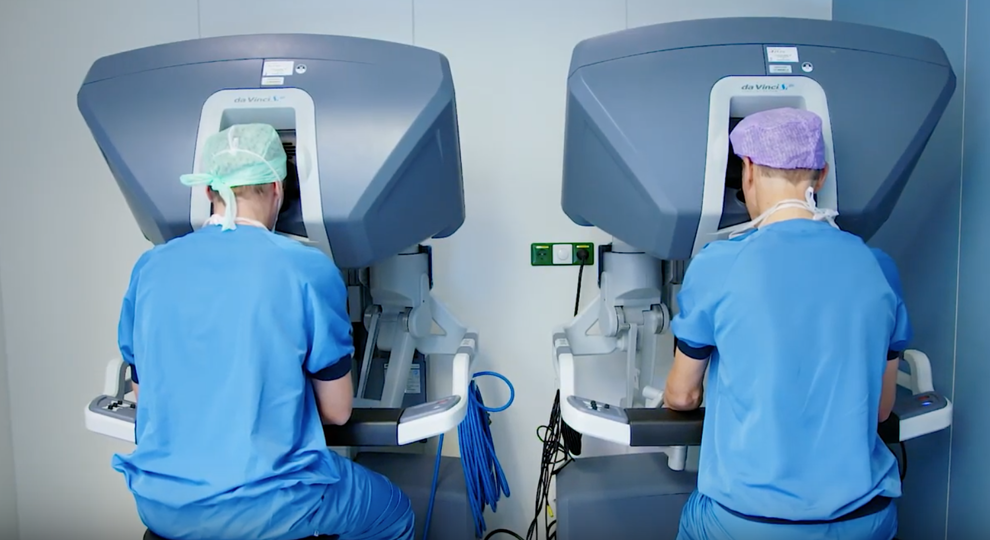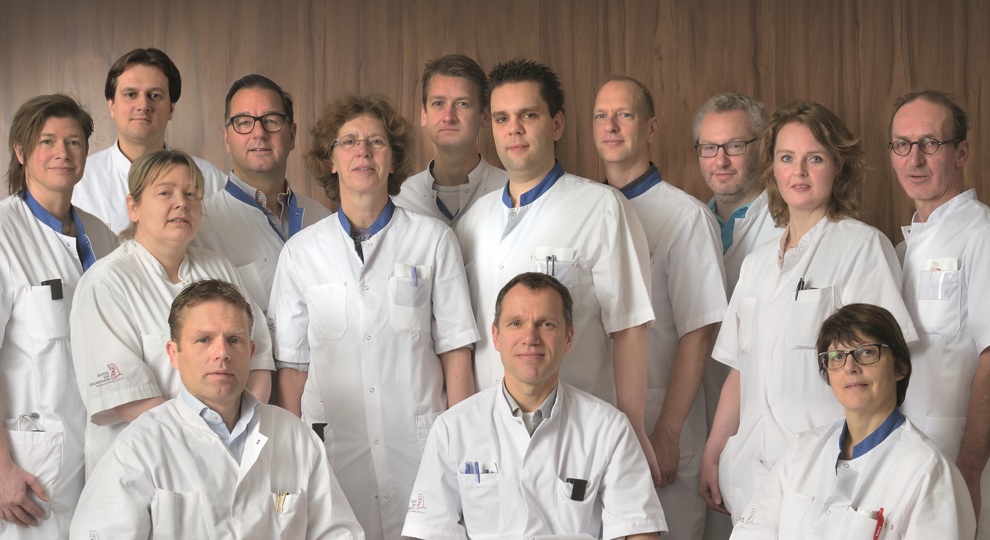Prostate cancer
Find out more about prostate cancer symptoms, its various types, the most common tests and treatment options on this page, as well as an overview of frequently asked questions.
Click here for more information about our NKI Prostate cancer center, our specialists, our patient satisfaction ratings, trials, and innovation.
Prostate cancer symptoms
Prostate cancer is a slow-growing cancer type that does not immediately cause symptoms. Prostate cancer is often coincidentally detected during a consultation about urinary problems or similar issues, or after the tumor has spread through the body to the bones or lymph nodes, which will cause symptoms to occur.
PSA (Prostate-Specific Antigen) is a protein that is found in small amounts in the bloodstream of all men. It is produced by the prostate glands. An unhealthy prostate will release more PSA into the bloodstream. This can be caused by a benign enlargement or infection but is most often found in patients with prostate cancer.
Elevated levels of PSA in the bloodstream can be an indicator of prostate cancer. If your PSA levels are only slightly elevated, your general practitioner will probably advise you to wait a while before repeating the tests. Elevated PSA levels do not automatically mean that you have cancer. Please see your general practitioner if you have any concerns.
If your PSA levels are elevated, you might want to consider seeing a medical specialist for further testing. Our Rapid Diagnostics can offer quick results.
What is a normal PSA level?
Your PSA level will naturally rise with age. We currently use the following values as an average for healthy men. You should not experience any problems if your levels are lower than the values listed:
- 40 to 55 years old: below 1.5
- 55 to 65 years old: below 2.5
- 65 to 75 years old: below 3.5-4
Types of prostate cancer
Prostate cancer develops in the glandular tubes of the prostate. The risk of developing prostate cancer increases with age. Although prostate cancer is most commonly diagnosed in men over 65, it is possible to develop a tumor at a younger age, starting at approximately 45 years old.
When treating prostate cancer, we differentiate between:
- Localized prostate cancer
- Recurrent prostate cancer that has come back after earlier treatments
- Locally advanced prostate cancer
- Advanced prostate cancer
Tests and diagnosis for elevated levels of PSA
Testing
In case you have ongoing or strong suspicions of prostate cancer, your general practitioner can refer you to undergo an MRI scan of the prostate. an MRI scan creates a detailed picture of your prostate which will help your doctor see if there is cancer in your prostate. At the Netherlands Cancer Institute, we will always do an MRI scan before a prostate biopsy.
Diagnosis
Depending on the results of the MRI scan and the PSA test, we will decide whether to proceed with a biopsy. We use the MRI scans to take the biopsy and take tissue samples from areas that look suspicious. All our biopsies are transperineal (the skin between the testicles and anus), not through the rectum. This lowers the risk of infection. You can read more about prostate biopsies here.
Testing and diagnosis prostate cancer
Before we start your treatment, we will do some tests. We will try to determine the placement of your tumor, wat type it is, how fast it grows, and whether it is metastatic. Often, this means we will do several nuclear imaging scans such as an MRI scan, PSMA PET scan, bone scan (skeletal scintigraphy), or CT scan.
In the case of metastasis (advanced prostate cancer), we will often perform a PSMA PET scan, or CT scan and skeletal scintigraphy.
Diagnosis
Your diagnosis will be reviewed by a multidisciplinary team. This means that several specialists with a specialization in prostate cancer will discuss your case, in order to come up with the best treatment plan for you. We will find the most fitting treatment plan together with you. You might have several treatment options to choose between.
We will give you a clear and honest explanation of all treatment options, their success rates, and their effects, so you can make an informed decision on your preferred treatment plan.
Treatment options
Your treatment options will depend on the type of prostate cancer diagnosed, the stage, any potential symptoms, as well as your overall health and physical condition. You will be informed about the entire process before the start of the treatment, and there will be room for questions.
When determining treatment options, we distinguish between:
- Localized prostate cancer; usually treated through surgery or some type of radiation therapy, occasionally in addition to hormone therapy. Not all forms of prostate cancer require treatment, although we will continue to monitor the tumor.
- Recurring or locally advanced prostate cancer; usually treated through surgery or a combination of radiation therapy and hormone therapy.
- Advanced prostate cancer; usually treated through a combination of hormone therapy, chemotherapy, and radiation therapy.
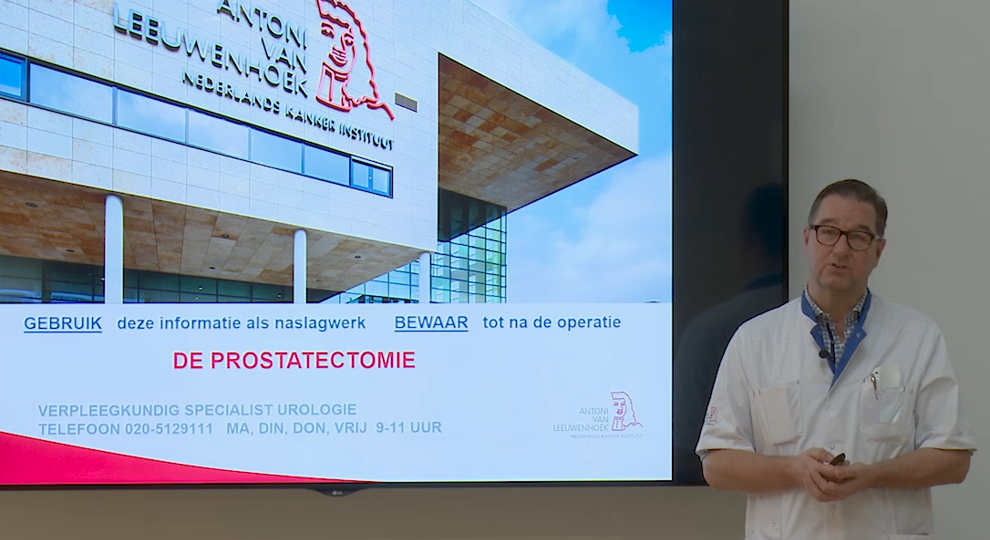
Prostatectomy Information
The NeuroSAFE technique
All prostate cancer surgeries at the NKI prostate cancer center make use of the NeuroSAFE technique. This technique was developed at the Martini-Klinik in Germany and aims to preserve the nerves. Nerve-sparing will lower the odds of bladder control issues or erectile dysfunction after surgery.
The Dutch prostate cancer center, of which the NKI prostate cancer center is part, closely collaborates with the Martini-Klinik in prostate cancer treatment research.
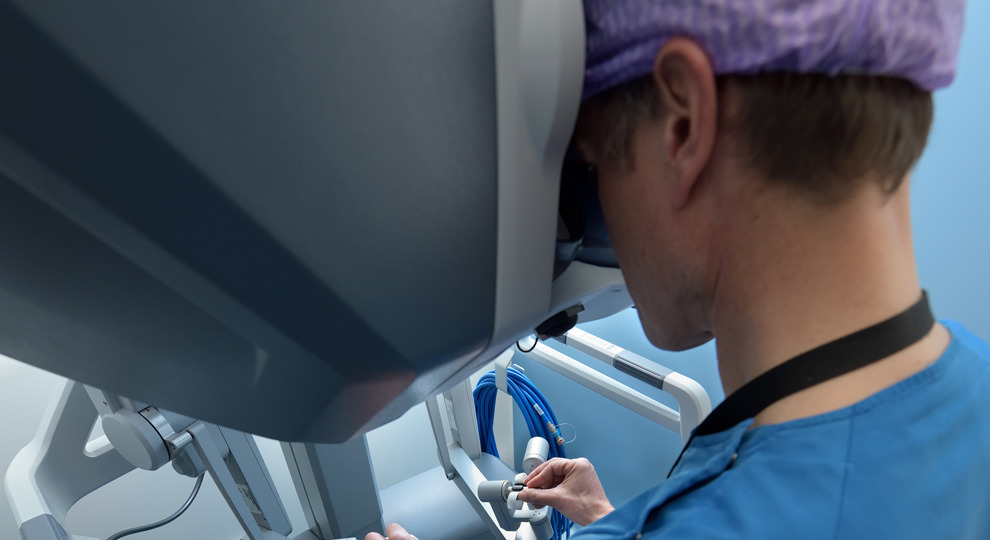
Robotic surgery (Da Vinci Robot)
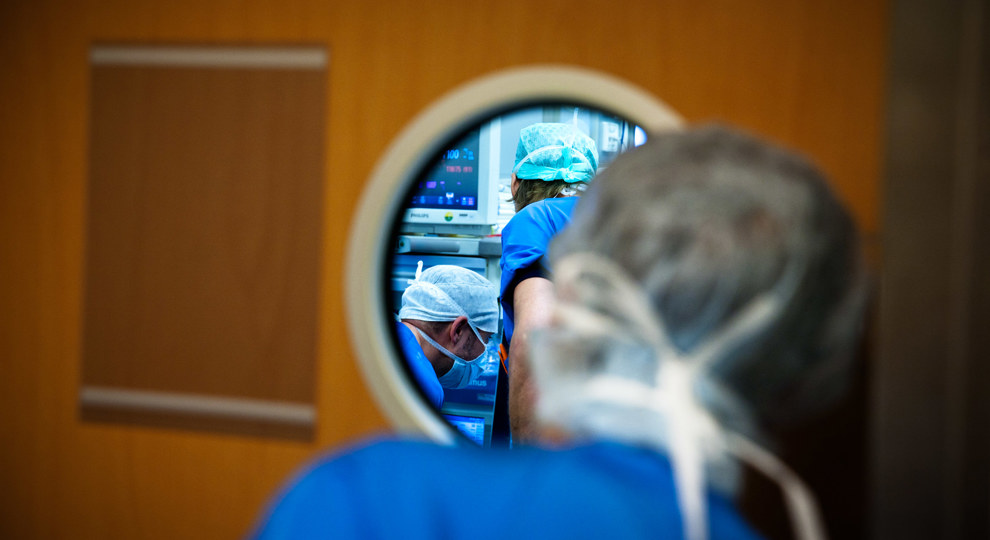
No-risk waiting times
Frequently asked questions
How can I request a second opinion at the NKI?
Please contact your practicing physician at your current hospital or your general practitioner. He or she can submit your request digitally here, together with any further medical information and test results. Any visual materials can be submitted by mail on a CD-ROM. It might take some time before all materials have arrived, but once your submission is complete, our medical team will review your request and our Planning department will contact you to schedule an appointment. It might take some time before all materials have arrived, but once your submission is complete, our medical team will review your request and our Planning department will contact you to schedule an appointment.
How long will I have to wait for my appointment? Even if I have not received my diagnosis?
If your general practitioner suspects prostate cancer based on elevated PSA level or a rectal exam. You will rarely have to wait more than 24 hours before your visit. We try and schedule as many diagnostic tests as possible during these rapid diagnostic days, in order to bring you the results as soon as possible. We might have to take an MRI scan of your prostate if we suspect the presence of prostate cancer and we want to take a biopsy.
Do you always use a robot for surgeries?
Yes, we use the Da Vinci robot for every prostate surgery (prostatectomy).
When should I worry about my PSA levels?
The presence of PSA in the bloodstream is normal. Men under 40 years of age should have a value below 1 ng/ml. Men between 40 and 55 years old should have a value below 1.5, men between 55 65 years old should have a value below 2,5, and men over 65 should have a value below 3.5-4.0.
PSA elevations above these values often require further testing. If your PSA levels are only slightly elevated, your general practitioner will probably tell you to wait a while before repeating the tests. Elevated PSA levels do not automatically indicate cancer. Your PSA levels may vary depending on the moment of testing, or the elevation may be caused by benign prostate abnormalities. Please see your general practitioner if you are concerned.
What is prostate cancer?
Prostate cancer (prostate carcinoma) is the most common cancer type in men. Prostate cancer develops in the glandular tubes of the prostate. The prostate is a gland positioned right below the bladder that gets larger after the age of 30. This might lead to prostate abnormalities. Prostate cancer is most commonly diagnosed in men over 65. The male hormone testosterone plays a role in the development of prostate carcinomas. Our Western diet (red meat, animal fats, not enough vegetables or fruit) might be a factor as well. There can also be a hereditary factor involved, considering the increased risk in children and family members of people with prostate cancer.
What are the symptoms of breast cancer?
There are no early symptoms of prostate cancer. You may experience urination or bowel problems once the tumor has progressed to a later stage. In the case of metastasis, you may experience pain in the bones or lymph nodes.
How do rapid diagnostics work?
Once your registration by your general practitioner or practicing physician is complete, you will be contacted by the Netherlands Cancer Institute’s clinical planning department. They will let you know whether rapid diagnostics is an option for you, and can tell you more about the process. Rapid diagnostics is a demanding process and can be exhausting. You will undergo various diagnostics tests and have scheduled consultations with many physicians during the day.
We expect any patient undergoing our Rapid Diagnostics to be physically able to handle such a day. We also recommend bringing a loved one for support.
How should I prepare for rapid diagnostics?
Suspected prostate cancer can be confirmed through a biopsy. Please use antibiotics before your prostate biopsy to prevent urinary tract or prostate infections after the biopsy. Our planning department will send you an appointment letter including a list of things to bring to your appointment. Please read the letter carefully and if applicable, fill out all questionnaires to ensure that you are prepared for the consultations with your doctors and have time to prepare questions. We recommend bringing a loved one to your appointment who can hear the consultation together with you.
What tests to expect during rapid diagnostics?
On a rapid diagnostics day for suspected prostate cancer, you will receive a blood test, physical examination, a prostate ultrasound, and possibly an MRI scan of the prostate. We will only opt for an MRI scan if prostate cancer is strongly suspected.
Why is the NKI prostate center part of the Netherlands Prostate Cancer Network (Prostaatkankernetwerk Nederland)? And what does this mean for me?
We believe that sharing knowledge and expertise and concentrating surgeries can lead to optimal patient care. This aligns with the view of the Prostate Cancer Foundation. You will not immediately notice this partnership as a patient of the Dutch Cancer Institute. If you are a patient to one of the other hospitals in our network (Amsterdam UMC, Noordwest Ziekenhuisgroep, Rode Kruis Ziekenhuis, St. Jansdal of Andros Mannenkliniek), you will have to come to the Netherlands Cancer Institute for your surgeries. Your hospital will discuss this with you. Usually your urologist will join the surgery team during your operation. All care before and after the surgery will be at 'your' hospital.
I have been diagnosed with prostate cancer. My options are surgery or radiation therapy. What is the best choice?
This depends on your personal situation. There is no universal best choice. We try and cure localized prostate cancer. Both treatment options have equal success rates. The treatment itself and the side effects will be different, however. Please see which treatment option would be the most suitable for you based on your lifestyle and expectations. The final choice is yours.
Both treatments have side effects that can determine your preferred treatment option. Side effects include erectile dysfunction, fatigue after treatment, incontinence after prostate removal, or bladder or intestinal irritation after radiation therapy. Your age and physical well-being affect which side effects you will experience. In the case of a recurrence of prostate cancer after surgery, there is still the option of radiation therapy.
What kinds of incontinence or erectile dysfunction symptoms can I expect after prostate removal?
There is a risk of incontinence during the first weeks after prostate removal. The effects differ. Some men only lose several drops of urine during exertion (stress incontinence), and others experience more severe issues after surgery. One contributing factor is the length of the urethra that remained after prostate removal surgery.
We will try to make a personal prediction on your chances of regaining continence six months after surgery and will discuss this with you before your surgery. It will take a year before we know the final results of your continence. For the best results, please do regular pelvic floor exercises during this year. Your urologist or nursing specialist can refer you to a registered pelvic physical therapist.
Permanent erective dysfunction may occur if no nerve pathways are spared during surgery. The quality of your erection before the surgery and your age also affect your odds. Before your surgery, we will assess whether a nerve-sparing surgery is an option for you.
My prostate cancer came back. What are my options?
Prostate cancer can recur despite treatment. it can come back in the areas that had been subjected to radiation treatment, or the area after prostate removal. It can also come back as metastases in lymph nodes or bones. Treatment may be an option. Your practicing physician can tell you more about your options based on your personal situation.
There are no more treatment options. Is there something that might help me?
There might be a study (also known as a trial or research study) available for you. Your practicing physician can tell you more about your options based on your personal situation.
Can I afford to wait and postpone an active treatment like my urologist suggested?
Our national guideline prostate carcinoma recommends active surveillance as a treatment option for patients with very small tumors. This involves regular PSA tests and repeated MRI scans and prostate biopsies for one year to 18 months. This treatment option is more than just "waiting" - we closely follow the tumor. If you have a low-risk tumor and are interested in active surveillance treatment, you can choose to follow this plan.
Will my insurance provider cover a second opinion?
Yes. All care offered at the Netherlands Cancer Institute is covered by insurance. This includes a second opinion.
What are the benefits of an MRI scan?
Men with suspected prostate cancer benefit from an MRI scan as the MRI imaging can determine whether a biopsy is necessary. The MRI scan can differentiate between aggressive forms of cancer that require treatment, and non-aggressive tumors that (probably) won't be dangerous. This might mean that active surveillance is an option for you, which will help you avoid all side effects. If you have prostate cancer, the MRI scan will let us know how advanced the cancer is. That is why the NKI Prostate cancer center uses MRI scans to trace prostate cancer and to look at the advancement of the tumor.
 nl
nl
 Nederlands (Nederland)
Nederlands (Nederland)
 English (United States)
English (United States)
